Rebuild Nav Station (Shelves, Panels, and Wiring)
I'm not sure how it got started, but I ended up rebuilding nearly
the whole Nav Station. At first I was just going to clean up the
wiring to the instruments and entertainment system. The
previous owner had a home-style DVD player, an RF modulator
to send its output to the TV's over a coaxial cable,
not the best approach, and had more or less just rudely stuck the VHF,
SSB, DVD player, Fishfinder, Raymarine network switch,
and assorted wall-warts into the various compartments. For
example the SSB was not mounted properly, it was essentially
just sitting on a shelf, and could be easily damaged in
heavy weather or a knock down.
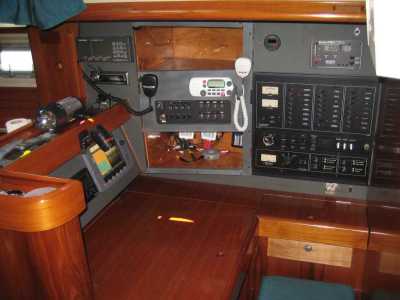
Many issues drove the design of the new Nav Station.
For instance, when we got Rhapsody, there was an old cassette player
with a 6 CD changer. On Mandala, I had already burned my entire record
collection to MP3s on CDs, so I wanted to install a CD/MP3
player and get rid of the the CD changer. When I went
to remove the old CD changer, it turned out that I had to
deconstruct part of the cabinets to get it out.
I ended up replacing it with a drawer that I built and
carefully stained and laquered. It is the lighter panel
in the bottom right of the above photograph, and
gives me an extra 1/2 cubic foot of storage in this
very important area.
I started removing all the instruments and electronics,
and the next thing I knew I was disassembling the cabinetry and
designing and building new shelves.
What I originally thought of as a one day task ended up
taking several weeks as I removed all of the old shelves,
designed and installed new ones, and rewired everything.
Another example is what I call the "Solar Controller Compartment",
shown below. On it is the controller for the solar panel, and
behind it is a space containing some wires, relays, and
fuses that one needs to get to. The panel
could be removed, but not completely, since the wires
to the solar controller had to remain attached.
This was awkward to work with and could only dangle
precariously when opened, so I decided to change it into a door.
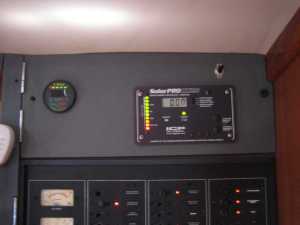
I added hinges (visible on the left of the above photo)
and made it open right-to-left, as shown in the first photo
below. Now it can open and close easily. Of course,
I had to rewire the panel so that the wires ran
over to the hinges and make various cuts to the
moulding around the door so that it would
open correctly. And, of course, I also added labels
to all the wires and wire ties and brackets to
organize the wires neatly. I also added a switch
to turn the solar panel on and off, and re-mounted
the power meter (the round dohickey) on this panel.
The centerpiece of the new Nav Station is the
new center compartment, in the
center photo above.
It was difficult to match the mottled grey of the old facia.
It was previously a laminate, and the only solution I could
come up with was a combination of grey-primer and black
speckled rust-oleum, sanded lightly to match the shade.
It looks pretty good tho, and the untrained eye would not
notice the difference.
The swinging door holds the VHF (which is now well
mounted, with all of it's wires carefully tied and
labelled) and the new black electrical panel
that I designed and created. This panel contains
switches and fuses for a bunch of things, particularly
for the new Integrated Audio/Video System, which I will
describe in the next section.
What you can't see in the above photos are the
new internal shelves that now
hold the Fishfinder and Raymarine Network Switch
securely, the innumerable wires and connectors that
I had to add, the extra holes I cut to run wires to and fro,
and the fact that I diagrammed and labelled
every wire in this fairly complicated area of the boat.
Also I did not take a good set of "before" pictures, so
it is hard for the reader to see what has really been done
here. But take my word for it, it was a lot of work,
and I feel this has been a great improvement to Rhapsody.
Design and Install Integrated Audio/Video System
Perhaps the piece-de-resistance of the refit is the integrated
Audio/Video System. Below is a photo of the TV in the salon.
It is showing the Instruments numerically on the left, and
a DVD of the Grateful Dead (Jerry Garcia), in a window
on the right.
At some point I realized that there was the potential to setup a
really cool video system on this boat. I already knew I was
going to have 5 devices capable of displaying video:
- The 22" flat screen TV in the salon
- The 17" flat screen TV in the master bedroom
- The new FLS on the port helm could display videos (had a video input)
- The Chartplotter on the starboard helm could also display video
- as well as the Charplotter at the nav station
I also knew that I was going to have a host of things I wanted
to display, including a DVD player, computer, video
cameras, and so on.
I thought about this system for a long time, from the
moment I saw Rhapsody, thru the haulout and so on, for
several months, gathered pieces, made designs, and tested
and installed parts of the system, before finally fully
implementing it at the very end ... the final work, of course,
had to wait until I had rebuilt the Nav Station, above.
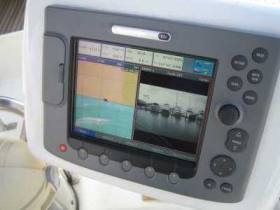
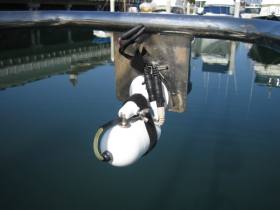
First a word about the Chartplotters. These are Raymarine E80's,
and there is one at the starboard Helm and one at the Nav Station.
These are essentially full blown computers and display devices.
Not only are they capable of very sophisticated navigation
functionality, but they are also capable of both outputting
their video as VGA and taking in up to 4 video inputs
each on RCA connectors. The one at the Nav Station is
connected to the radar Radome on the mast, and is the primary server
of radar information. The Chartplotters are hooked up to each other,
and to the DSM300 fishfinder by an ethernet network and hub.
This is called the "Raymarine Network".
The Chartplotters are also hooked to all the other instruments
on the boat thru a separate serial network, called the "SeaTalk Network".
The sensors and instruments on this network include
the GPS antenna, the wind speed and direction (measured at the top
of the mast), the boat speed (measured by a paddlewheel under the boat)
and direction (measured by a flux-gate compass mounted in one of the cabins),
the rudder deflection (measured by a sensor on the rudder post),
and the ST50 sonar depthfinder. The autopilot is also on the
Seatalk network. In general each sensor on this network
is connected to a dedicated instrument (i.e. the wind-speed
sensors are connected to an insturment at the helm), and then
the instruments are networked together by a serial cable
that also provides power to them. Got it?
Whew!
All of these inputs go to the Chartplotters, which are cabaple of
displaying them in a bewildering array of possibilities. For
instance, you can have the radar in one window and a DVD in
another one. Or you can have the radar overlayed on a chart
overlayed with a google-earth type picture in one window,
and the fishfinder in another one. Or you can split the
screen into four windows and show four different video
cameras simultaneously in each window. And, importantly,
once again, the Chartplotters themselves can act as
video output devices (i.e. I could conceivably show the
output of the Chartplotter on the FLS screen lol).

Another factor that figured strongly into my design for this system
was that there have been great strides made in automotive AV systems
in recent years. What with all the DVD players on the back of SUV
headrests, all of a sudden there are all these sophisticated devices
that one can obtain and hookup that run off 12V auto power instead
of home 117V power. So a key consideration was how to make all
this work without the use of wall warts and turning on the Invertor,
Generator, or being hooked to shore power. The key piece arrived when,
looking for a replacement for the old cassete deck and wanting an
MP3/CD player, I discovered that "nowdays" I could get an in-dash DVD player.
This eliminated the old home-style DVD player that the previous
owner had installed and made it feasable to run everything off of
12V.

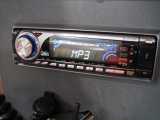
The other key piece is the 4x4 video matrix switch, also built
for automobiles, shown below. It allows me to route any one
of four video inputs to any one of four video displays. I
mounted it inside a Pelican Case, in the "wiring compartment"
under the floor next to the nav station.
I added a VGA scan convertor for the main chartplotter output, which
changes it from a bulky VGA cable to the familiar 3-RCA component
video cables, and another VGA scan convertor for the laptop computer.
I also mounted an outdoor day-night "surveillance" camera on the
bow, as well as a second wireless surveillance camera that could
grow into it's own system of four cameras, that is not shown,
and which I'm still integrating, but should allow me to
place cameras at other strategic places on the boat.
So now I can describe the inputs to the system:
- DVD Player
- Chartplotter
- Computer
- Video Camera(s)
The inputs go to the video switch and then, to the ouptputs. That's about it.
The only thing remaining was to hook it all up, and I would be able
to, well, show anything on anything.
Of course, I had to run wires all over the boat to do this, and
some of them had to be run weeks and weeks before I implemented
the final system. For instance, before the new batteries
were put in, while the old ones were still out and I could get
to the bilge compartments, I had to run a wire from where
the bow camera would be, all the way back to the Nav Station.
I didn't hook the bow camera up until the very end.
All the wires had to be tied
(I found that velcro strips work well for bundles that
I might want to add or remove from in the future) and labelled
(using the special waterproof vinyl inkjet paper I had found).
That's what made this improvement so difficult.
There was a lot of planning, diagramming, "dry-fit" testing,
and so on, to get it figured out before I could proceed. And there
was a tremendous amount of detail work, soldering, putting
on connectors and power strips, and so on, to get it done.
And of course all the other improvements to the boat (plumbing,
upholstery, and so on) were going on simultaneously.
And I haven't even mentioned anything about the audio system, which
includes the CD player, a separate automobile 200W amplifier,
speakers in the salon and the cockpit, as well as
speaker output from the SSB and VHF, computer and so on.
For instance, the new switch panel I created allows me to
direct either the SSB/VHF to an additional, louder, external speaker,
if I so desire. Heck, the CD player is bluetooth ready and even has a
USB port, but that's another story.
The only thing left, I guess, is to explain why I would go to all
the trouble, time and expense, to hook all this stuff up. There
are a couple of clear examples that come to mind. I imagine
it will be really nice to be able to come down off the deck for
15 mintues sometimes on long passage to have dinner, and
be able to watch the radar (in one window) and a camera pointing
out the front of the boat (in another window)
on the salon TV while doing so. Or, as another example,
we might be sitting in an anchorage at night, watching a DVD
and at the same time, be able to monitor the depth of the water
under the boat. If you've been there you know how reassuring
that can be, and what a pain it is to go up in the cockpit
every 15 minutes just to check the depth of the water.
The system is even setup so, using only the TV controller,
I can switch between a full screen DVD and the chartplotter
showing instrumentation with that same DVD in a window.
In the end, Rhapsody is all about the possibilites that the
future, and the trip, will bring, and that has led me to the
design of this integrated audio/video system. From a technical
point of view, it provides me with the flexibility to decide
later what I want to see on any display or hear thru the speakers,
by merely pressing a button, and does not require me to run
or solder new wires every time I want to make a change.
The system is as flexible as possible and gives
me the most possibilites, and after all, isn't that what's
it's all about?
Computers and Software
I've only just started to hook up the computer systems.
I've gotten all the Garmin Charts for
the trip, which work on the computer as well as our backup
handheld GPS. I gotten all the Raymarine Charts for the trip,
which work in the Chartplotters. I've added and rudimentarily
tested the new Raymarine RNS 6.0 PC Software that allows the
computer also to act as a chartplotter, displaying the
radar/fishfinder/instruments and so on, as well as allowing
me to plan courses using a mouse, import courses and
waypoints from other software, and things like recording
instruments over time and graphing the results.
I will be learning more about the computer systems
as I figure out how we're going to check the weather.
Beyond looking out the window or listening to radio
reports, I will be getting weather faxes,
which are current and projected weather maps that are
delivered to the computer over the SSB (shortwave) radio,
and which can be fed into the whole Chartplotter/Computer
system. For instance, believe it or not, there is a module
in the PC software that will actually plot the best course
for us, depending on how we define that (winds not too low,
but not too high either, thanks), given our desired begin
and endpoints, and given the currents and winds from the
weather maps. It's pretty mind boggling and I'm looking
forward to checking it out.
Another area which will be rife with improvements,
and which will involve the computers will be the
communications systems.
At this point I have Verizon Broadband wireless, which
suprisingly, I think will work in most of the major
Mexican ports we will be visiting. So I should be
able to make phone calls, surf the web, pay bills,
check our email, and so on in most of these ports.
I also have Wi-Fi ... but neither of these technologies
will work at sea or in primitive anchorages.
Therefore, I will be adding a Sat Phone to the boat
(probably Iridium) which will afford voice and
limited data comunications anywhere I might go.
Note that, even though I'd like one, at this point full blown
satellite uplinks are not economically feasible for
most cruisers as they cost well over $1000/month.
So, in certain places, I'll be limited to the sat
phone, and even it will be expensive, so I will
have to use it sparingly.
I'll probably also add a Pactor Modem which
allows for limited data communications over the
SSB shortwave radio (the weather faxes can be gotten
without a modem, just plug the SSB directly
into the PC sound card and run some software).
Once the modem is installed, there are free
services available that will let me send
and receive limited emails and do things like
post reports of our position on a webpage.
These redundant capabilities might be handy
for staying in touch in really remote situations,
when the sat phone might not work and/or might
be too expensive. One way or the
other, the redundancy will be nice to have,
especially as I'm going to have to use the Net to
pay bills and maintain certain links to the
land all the time, and it will be crucial to
have good communcations throughout the trip.
But more on these improvements
when they actually happen, eh? I've already
done a few more improvements that I haven't
yet told you about .....